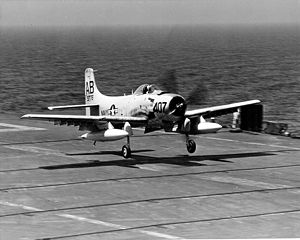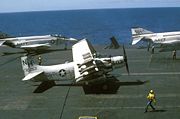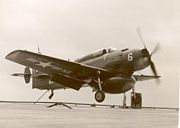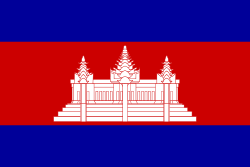A-1 Skyraider
| AD / A-1 Skyraider | |
|---|---|
 |
|
| U.S. Navy AD-6 Skyraider from Attack Squadron VA-15 catches a wire on the USS Forrestal (CVA-59). | |
| Role | Attack aircraft |
| Manufacturer | Douglas Aircraft Company |
| Designed by | Ed Heinemann |
| First flight | 18 March 1945 |
| Introduced | 1950s |
| Retired | 1970s |
| Primary users | United States Navy United States Air Force |
| Produced | 1945–1957 |
| Number built | 3,180 |
| Variants | A2D Skyshark |
The Douglas A-1 (formerly AD) Skyraider was a U.S. single-seat attack bomber of the 1950s, 1960s and early 1970s. A propeller-driven anachronism in the jet age, the Skyraider had a remarkably long and successful career well into the space age, and inspired a straight-winged, slow-flying, jet-powered successor which is still in front line service today, the A-10 Warthog.
It carried various nicknames including: "Spad" (a biplane aircraft of World War I), "Able Dog" (phonetic AD), the "Destroyer," "Hobo" (radio call sign of the USAF 1st Air Commando/Special operations Squadron), "Firefly" (602nd ACS/SOS), "Zorro" (22nd SOS), "The Big Gun," "Old Faithful," "Old Miscellaneous," "Fat Face" (AD-5/A-1E version, side-by-side seating), "Guppy" (AD-5W version), "Q-Bird" (AD-1Q/AD-5Q versions), "Flying Dumptruck" (A-1E), "Sandy" (Combat Search And Rescue helicopter escort) and "Crazy Water Buffalo" (South Vietnamese nickname).
Contents |
Design and development

The A-1 was originally designed to meet World War II requirements for a carrier-based, single-place, long-range, high performance dive-/torpedo bomber. Designed by Ed Heinemann of the Douglas Aircraft Company, the Skyraider was ordered in 6 July 1944 as the XBT2D-1. In April 1945, one month after its first flight on 18 March 1945, it was evaluated at the Naval Air Test Center (NATC).[1] In December 1946, after a designation change to AD-1, delivery of the first production aircraft to a fleet squadron was made to VA-19A.[2]
The AD-1 was built at Douglas' El Segundo plant in Southern California. In his memoir The Lonely Sky, test pilot Bill Bridgeman describes the routine yet sometimes hazardous work of certifying AD-1s fresh off the assembly line (quoting a production rate of two aircraft per day) for delivery to the U.S. Navy in 1949 and 1950.
The low-wing monoplane design started with a Wright R-3350 radial engine, later upgraded several times. Its distinctive feature was large straight wings with seven hardpoints apiece. These gave the plane excellent low-speed maneuverability, and enabled it to carry a tremendous amount of ordnance over a considerable combat radius and loiter time for its size, comparable to much heavier subsonic or supersonic jets. The aircraft is optimized for the ground-attack mission, and is armored against ground fire in key locations, unlike faster fighters adapted to carry bombs such as the F4U Corsair or P-51 Mustang, which would be retired by U.S. forces long before the 1960s.
The piston-engined, prop-driven Skyraider was a postwar follow-on to World War II dive bombers and torpedo bombers such as the Helldiver and Avenger. It was replaced in the 1960s by the A-4 Skyhawk as the Navy's primary light attack plane. Used over Korea and briefly over North Vietnam, it was adopted as the primary ground support attack for the U.S. Air Force and South Vietnamese Air Force (VNAF) during the Vietnam War, before being supplanted by the jet-powered A-37 Dragonfly in USAF and VNAF and the A-7 Corsair II in US Navy service.
Operational history
Korea

Though the Skyraider was produced too late to take part in World War II, it became the backbone of U.S. Navy aircraft carrier and United States Marine Corps (USMC) strike aircraft sorties in the Korean War, with the first ADs going into action from the USS Valley Forge with VA-55 on 3 July 1950.[3] Its weapons load and 10-hour flying time far surpassed the jets that were available at the time.[4] On 16 June 1953, a USMC AD-4 from VMC-1 piloted by Major George H. Linnemeier and CWO Vernon S. Kramer shot down a Soviet-built Polikarpov Po-2 biplane, the only documented Skyraider air victory of the war.[5] AD-3N and -4N aircraft carrying bombs and flares flew night-attack sorties, and radar-equipped ADs carried out radar-jamming missions from carriers and land bases.[4] During the Korean War (1950–1953) A-1 Skyraiders were flown only by the U.S. Navy and U.S. Marine Corps, and were normally painted in dark navy blue. A total of 101 Navy and Marine AD Skyraiders were lost in combat during the Korean War, and 27 were lost to operational causes, for a total loss of 128 Skyraiders in the Korean War.
Communist China
On 26 July 1954, two Douglas Skyraiders from the aircraft carriers USS Philippine Sea and Hornet successfully shot down 2 PLAAF La-7s off the coast of Hainan Island while searching for survivors after the shooting down of a Cathay Pacific Skymaster airliner 3 days previously , also by La-7s.[6]
Vietnam

In 1965, the A-1 Skyraider was still the medium attack aircraft in many carrier air wings, although it was slated to be replaced by the A-6A Intruder as part of the general switch to jet aircraft. Skyraiders participated in the first strikes against North Vietnam before they were replaced. During the war, U.S. Navy Skyraiders shot down two Soviet-built Mikoyan-Gurevich MiG-17 jet fighters: one on 20 June 1965, a victory shared by LT Clinton B. Johnson and LTJG Charles W. Hartman III of VA-25;[7] and one on 9 October 1966 by LTJG William T. Patton of VA-176.[5] While on his very first mission, Navy pilot LTJG Dieter Dengler took damage to his A-1H over Vietnam on 1 February 1966, and crash-landed in Laos.[8]
As they were released from Navy service, Skyraiders were introduced into the Vietnam Air Force (VNAF). They were also used by the USAF to perform one of the Skyraider's most famous roles: the "Sandy" helicopter escort on combat rescues.[9] USAF Major Bernard F. Fisher piloted an A-1E on the 10 March 1966 mission for which he was awarded the Medal of Honor for rescuing Major "Jump" Myers at A Shau Special Forces Camp.[10] USAF Colonel William A. Jones, III piloted an A-1H on the September 1 1968 mission for which he was awarded the Medal of Honor. In that mission, despite damage to his aircraft and suffering serious burns, he returned to his base and reported the position of a downed flight crew member.[10]

After November 1972, all A-1s in U.S. service in Southeast Asia were transferred to the South Vietnamese Air Force (VNAF) and their former roles were taken over by the subsonic A-7 Corsair II.[11] The Skyraider in Vietnam pioneered the concept of tough, survivable aircraft with long loiter times and large ordnance loads. The USAF lost 201 Skyraiders to all causes in Southeast Asia, while the Navy lost 65 to all causes. Of the 266 lost A-1s, five were shot down by surface-to-air missiles (SAMs), and three were shot down in air to air combat; two by North Vietnamese MiG-17s. The first A-1 was shot down on 29 April 1966, and the second A-1 was lost on 19 April 1967; both were from the 602 Air Commando Squadron (ACS). The third A-1 Skyraider was from Squadron VA-35 and was lost to a Red Chinese MiG-19 (J-6) on 14 February 1968. LTJG Joseph P. Dunn (USN), had flown too close to the Communist Chinese held island of Hainan, and had been intercepted. Lieutenant Dunn's A-1 Skyraider was the last U.S. Navy A-1 lost in the war, and he did not survive. Shortly thereafter, A-1 Skyraider naval squadrons transitioned to A-4 Skyhawks.
In contrast to the Korean War, fought a decade earlier, the US Air Force, in Vietnam, utilized the naval A-1 Skyraider for the first time. As the Vietnam war progressed, USAF A-1s were painted in camouflage, while USN A-1 Skyraiders were gray/white in color; again, in contrast to the Korean War, when A-1s were painted dark blue.
In 1965, to highlight the dropping of the six millionth pound of ordnance; CDR Clarence J. Stoddard, flying an A-1H, dropped a special, one-time only, object in addition to his other munitions – a toilet.[12]
Algeria
The French Air Force, the Armée de l'Air, bought 113 ex-U.S. Navy AD-4s and AD-4NAs in 1958 to replace aging F-47 Thunderbolts in Algeria. The aircraft were used from December 1959 until the end of the Algerian war. The aircraft were used by the 20e Escadre de Chasse (EC 1/20 "Aures Nementcha," EC 2/20 "Ouarsenis" and EC 3/20 "Oranie") and EC 21 in the close air support role armed with rockets, bombs and napalm. After the end of the war, the remaining aircraft were passed along to Gabon and Chad.
Adaptability
In addition to serving during Korea and Vietnam as an attack aircraft, it was modified into a carrier-based airborne early warning aircraft, replacing the Grumman TBM-3W Avenger. It served in this function in the USN and Royal Navy, being replaced by the E-1 Tracer and Fairey Gannet respectively in those services.[4]
Variants





Production ended in 1957 with a total of 3,180 built. However, in 1962 the existing Skyraiders were redesignated A-1D through A-1J and later used by both the USAF and the Navy in the Vietnam War.
The Skyraider went through seven versions, starting with the AD-1, then AD-2 and AD-3 with various minor improvements, then the AD-4 with a more powerful R-3350-26WA engine. The AD-5 was significantly widened, allowing two crew to sit side-by-side (this was not the first multiple-crew variant, the AD-1Q being a two-seater and the AD-3N a three-seater); it also came in a four-seat night-attack version, the AD-5N. The AD-6 was an improved AD-4B with improved low-level bombing equipment, and the final production version AD-7 was upgraded to a R-3350-26WB engine.
- XBT2D-1: Single-seat dive-bomber, torpedo-bomber prototype for the U.S. Navy.
- XBT2D-1N: Three-seat night attack prototypes, only three aircraft built.
- XBT2D-1P: Photographic reconnaissance prototype, only one built.
- XBT2D-1Q: Two-seat electronics countermeasures prototype. One aircraft only.
- BT2D-2 (XAD-2): Upgraded attack aircraft, one prototype only.
- AD-1: The first production model, 242 built (statistics in table).
- AD-1Q: Two-seat electronic countermeasures version of the AD-1, 35 built.
- AD-1U: AD-1 with radar countermeasures and tow target equipment, no armament and no water injection equipment.
- XAD-1W: Three-seat airborne early warning prototype. AD-3W prototype, one aircraft only.
- AD-2: Improved model, powered by 2,700 hp (2,000 kW) Wright R-3350-26W engine. 156 built.
- AD-2D: Unofficial designation for AD-2s used as remote-control aircraft, to collect and gather radioactive material in the air after nuclear tests.
- AD-2Q: Two-seat electronics countermeasures version of the AD-2, 21 built.
- AD-2QU: AD-2 with radar countermeasures and target towing equipment, no armament and no water injection equipment, one aircraft only.
- XAD-2: Similar to XBT2D-1 except engine, increased fuel capacity.
- AD-3: Proposed turboprop version, initial designation of A2D Skyshark.
- AD-3: Stronger fuselage, improved landing gear, new canopy design, 125 built.
- AD-3S: Anti-submarine warfare model, only two prototypes were built.
- AD-3N: Three-seat night attack version, 15 built.
- AD-3Q: Electronics countermeasures version, countermeasures equipment relocated for better crew comfort. 23 built.
- AD-3QU: Target towing aircraft, but most were delivered as the AD-3Q.
- AD-3W: Airborne early warning version, 31 built.
- XAD-3E: AD-3W modified for ASW with Aeroproducts propellor
- AD-4: Strengthened landing gear, improved radar, G-2 compass, anti-G suit provisions, four 20 mm cannon and 14 Aero rocket launchers, capable of carrying up to 50 lb (23 kg) of bombs. 372 built.
- AD-4B: Specialized version designed to carry nuclear weapons, also armed with four 20 mm cannon. 165 built plus 28 conversions.
- AD-4L: Equipped for winter operations in Korea, 63 conversions.
- AD-4N: Three-seat night attack version. 307 built.
- AD-4NA: Designation of 100 AD-4Ns without their night-attack equipment, but fitted with four 20 mm cannon, for service in Korea as ground-attack aircraft.
- AD-4NL: version of the AD-4N. 36 conversions.
- AD-4Q: Two-seat electronic countermeasures version of the AD-4, 39 built.
- AD-4W: Three-seat airborne early warning version, 168 built.
- Skyraider AEW. Mk 1: 50 AD-4Ws transferred to the Royal Navy.
- A-1E (AD-5): Side by side seating for pilot and co-pilot, without dive brakes, 212 built.
- A-1G (AD-5N) - Four-seat night attack version, with radar countermeasures, 239 built.
- EA-1F (AD-5Q) - Four-seat electronics countermeasures version, 54 conversions.
- AD-5S: One prototype to test Magnetic anomaly detector (MAD) anti-submarine equipment.
- EA-1E (AD-5W): Three-seat airborne early warning version.
- A-1H (AD-6) - Single-seat attack aircraft with three dive brakes, centerline station stressed for 3,500 lb (1,600 kg) of ordnances, 30 inches (760 mm) in diameter, combination 14/30 inch (360/760 mm) bomb ejector and low/high altitude bomb director, 713 built.
- A-1J (AD-7): The final production model, powered by a R3350-26WB engine, with structural improvements to increase wing fatigue life, 72 built.
- UA-1E: Utility version of the AD-5.
Survivors
- A-1E (s/n 52-132649) is on display at the National Museum of the United States Air Force in Dayton, Ohio. This aircraft was flown by Major Bernard Francis Fisher on 10 March, 1966 when he rescued a fellow pilot shot down over South Vietnam in the midst of enemy troops, a deed for which he was awarded the Medal of Honor. The aircraft was severly damaged in combat in South Vietnam and was returned in 1967 for preservation by the Air Force Museum.[13]
Operators

- See also: List of A-1 Skyraider operators
 Cambodia
Cambodia Central African Republic
Central African Republic Chad
Chad France
France Gabon
Gabon Philippines
Philippines South Vietnam
South Vietnam United Kingdom
United Kingdom United States
United States Vietnam
Vietnam
Popular culture

While the Skyraider is not as iconic as some other aircraft, it has been featured in some Vietnam-era films such as The Green Berets (1968), Flight of the Intruder (1991) flying as Sandy escort, and in We Were Soldiers (2002) in the ground support role. The Skyraider also played a leading computer generated role in Werner Herzog's Rescue Dawn (2007), retelling the story of Navy LT Dieter Dengler's escape from Laos. Skyraiders are also featured in the classic Korean war movie The Bridges at Toko-Ri (1953).
Specifications (A-1H Skyraider)

General characteristics
- Crew: One
- Length: 38 ft 10 in (11.84 m)
- Wingspan: 50 ft 0 in (15.25 m)
- Height: 15 ft 8 in (4.78 m)
- Wing area: 400.31 ft² (37.19 m²)
- Empty weight: 11,970 lb (5,430 kg)
- Loaded weight: 13,925 lb as scout; 18,030 lb as bomber (6,315 kg as scout; 8,180 kg as bomber)
- Max takeoff weight: 25,000 lb (11,340 kg)
- Powerplant: 1× Wright R-3350-26WA radial engine, 2,700 hp (2,000 kW)
Performance
- Maximum speed: 320 mph (280 knots, 520 km/h)
- Cruise speed: 295 mph (256 knots, 475 km/h)
- Range: 1,315 mi (1,142 NM, 2,115 km)
- Service ceiling 28,500 ft (8,660 m)
- Rate of climb: ft/min (m/s)
- Wing loading: 45 lb/ft² (220 kg/m²)
- Power/mass: 0.15 hp/lb (250 W/kg)
Armament
- Guns: 4 × 20 mm (0.787 in) cannon
- Other: Up to 8,000 lb (3,600 kg) of ordnance on 15 external hardpoints including bombs, torpedoes, mine dispensers, unguided rockets, or gun pods
See also
Related development
- A2D Skyshark
Comparable aircraft
- A-4 Skyhawk
- A-37 Dragonfly
- T-28 Trojan
- A-10 Thunderbolt II
- Westland Wyvern
- Ilyushin Il-10
Related lists
- List of attack aircraft
- List of military aircraft of the United States
References
Notes
- ↑ Mersky 1983, p. 144.
- ↑ 4.0 4.1 4.2 Johnson, E.R. (2008), "Able Dog", Aviation History (Sept 2008)
- ↑ 5.0 5.1 Grossnick and Armstrong 1997
- ↑ Air Clash off Hainan - South China Morning Post, 27 July 1954.
- ↑ Clinton Johnson. Skyraider vs Mig-17
- ↑ Dengler, Escape from Laos
- ↑ "Douglas A-1H and A-1J", National Museum of the United States Air Force. Retrieved: 30 December 2007.
- ↑ 10.0 10.1 Medal of Honor Citations: Vietnam War Medal of Honor Recipients (A-L), U.S. Army Center of Military History, 16 July 2007. Retrieved: 23 December 2007.
- ↑ "Rescue in Vietnam", National Museum of the United States Air Force. Retrieved: 30 December 2007.
- ↑ USS Midway
- ↑ United States Air Force Museum (1975 edition)
Bibliography
- Dengler, Dieter. Escape from Laos. New York: Presidio Press, 1979. ISBN 0-89141-076-7.
- Grossnick, Roy A. and William J. Armstrong. United States Naval Aviation, 1910–1995. Annapolis, Maryland: Naval Historical Center, 1997. ISBN 0-16049-124-X.
- Hobson, Chris. Vietnam Air Losses, USAF/USN/USMC, Fixed-Wing Aircraft Losses in Southeast Asia, 1961-1973. North Branch, Minnesota: Specialty Press, 2001. ISBN 1-85780-1156.
- Mersky, Peter B. U.S. Marine Corps Aviation: 1912 to the Present. Annapolis, Maryland: The Nautical and Aviation Publishing Company of America, 1983. ISBN 0-933852-39-8.
- Swanborough, Gordon and Peter M. Bowers. United States Navy Aircraft since 1911. London: Putnam, Second edition 1976. ISBN 0-370-10054-9.
- United States Air Force Museum (1975 edition)
External links
 |
Wikisource has several original texts related to: Audio recordings and transcripts with comments of actual Wild Weasel missions flown during the Vietnam War, including Sandy-assisted rescue. |
- Skyraider.org
- Douglas AD/A-1 Skyraider
- Air Force Fact sheet on the Douglas A-1E Skyraider flown by Major Fisher
- Abledogs.com
- The A-1 in Airpower Classics from Air Force Magazine
- AeroWeb: List of A-1 survivors on display
|
|||||
|
|||||
|
|||||
|
||||||||||||||
|
||||||||||||||